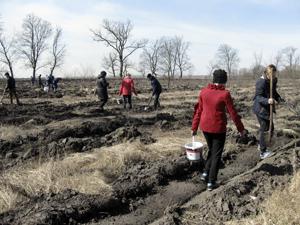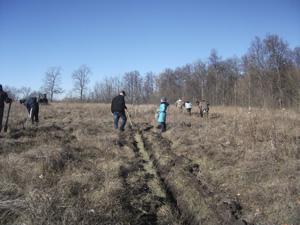Oksana Abduloieva
Other projects
9 Jul 2013
Preservation of Floodplain Landscapes within the National Nature Park ‘Pyryatynsky’, Dnipro River Basin, Ukraine
The standing initiative for the measures providing conservation of crucial natural habitats in the park such as reed wetlands and oak woodlands will be implemented.

Planting oak.
We will implement measures for natural habitats such as reed wetlands and Quercus-Carpinus-Tilia woodlands on rich soils. The great challenges for the habitats in the national park are intentional burning of old grass and deadwood and fragmentation. We propose winter harvesting of reed for conservation of floodplain habitats and planting of oak stands for restoration of woodlands based on landscape planning. We will increase both our team and public experience in restoration of habitats.

Our first testing plot for planting oak is an abandoned pasture invaded by alien weeds and potentionally covered by oak woodlands in the past.
Our tasks are:
To apply winter harvesting of common reed as sustainable practice, make a preliminary estimation of impacts of different winter modes that are applicable to migratory and other vulnerable animals and correct the guidelines on the management of the floodplain.
To arrange public relations in order to overcome intentional fires in reeds.
To plant native oak stands, at least on the area of 3 hectares, as the first step to restore woodland habitats and to take actions for conservation of associated vulnerable species, based on own data and references, and using "close-to-natural" practices for habitats and populations restoration.
To support nature conservation education in local communities and develop attractive standing initiative for implementation of local public environmental ambitions in the national park.
We apply our proposals on the management of reed wetlands, GIS-map and fundamentals of landscape planning derived from the first project as tools in the second project.
The positive impact of reed wetlands management should be expected for a few dozen animal species of the Bern Convention annexes and the Red Book of Ukraine. The target species of the measures associated with woodlands are: cavity-nesting birds such as owls (Athene noctua, Strix aluco, Asio otus), Parus major, P.caeruleus, insects (bee Xylocopa violacea, bumblebees, wasps); herb plants (Pulsatilla patens, Galanthus nivalis, concomitant spring ephemeroid herbs). Artificial nestings for cavity-nesting birds and Hymenoptera insects will be placed. We will arrange the birdwatching tower for long-term observations and education of young people. To accelerate restoration of herb layer in disturbed woodland we will test reintroduction of seed mixtures of ephemeroid herbs. Public will be involved in all events. Results of the project will be disseminated at the regional level. The project timescale is till August 2017. The team working with me has the experience both in plant and animal biodiversity, nature conservation practices and public relations.